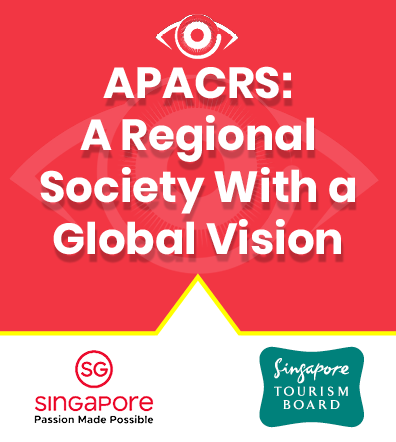Eyeworld Weekly Update |
Volume 19, Number 43 |
12 December 2014 |
- True-color confocal scanner granted U.S. clearance
- Rhopressa phase 3 study completes enrollment
- Tie2 activator study for DME completes enrollment
- AAO: Ocular vitamins do not match scientific evidence
- RPB announces Stein Innovation Awards
- Flying Eye Hospital earns patient safety accreditation
True-color confocal scanner granted U.S. clearance
A fully automated retinal imaging system has received 510(k) approval, developer CenterVue (Fremont, Calif.) said in a news release.The Eidon true-color confocal scanner combines confocal imaging and white light illumination in order to provide "greater contrast and superior image quality over a traditional fundus camera," the company said.
Rhopressa phase 3 study completes enrollment
Rocket 1, the 400-patient phase 3 registration trial evaluating a once-daily, triple-action eye drop being tested for its ability to lower intraocular pressure (IOP) in patients with glaucoma or ocular hypertension, has completed enrollment, developer Aerie Pharmaceuticals (Bedminster, N.J.) said.The study will measure efficacy over 3 months. The primary efficacy endpoint of the trials is to demonstrate non-inferiority of IOP lowering for Rhopressa compared to timolol. Preclinical results have demonstrated that Rhopressa also lowers episcleral venous pressure, which contributes approximately half of IOP in healthy subjects. Further, Rhopressa provides an additional mechanism that reduces fluid production in the eye and therefore lowers IOP. Biochemically, Rhopressa is known to inhibit both Rho kinase (ROCK) and norepinephrine transporter (NET), Aerie said in a news release.
Tie2 activator study for DME completes enrollment
TIME-2, a phase 2 study evaluating Tie2 activator AKB-9778 alone and in combination with ranibizumab for the treatment of diabetic macular edema, has completed enrollment, developer Aerpio Therapeutics (Blue Ash, Ohio) said in a news release.AKB-9778 is a first-in-class small molecule that inhibits the human protein tyrosine phosphatase β (HPTPβ) enzyme, which acts as a negative regulator of the Tie2 receptor. Results from a phase 1b study demonstrated "promising" monotherapy activity in both treatment-naïve and treatment-resistant DME patients, the company said.
TIME-2 enrolled 144 subjects (48 patients/group) at nearly 40 sites in the United States, randomizing patients 1:1:1 in three groups: 1) AKB-9778 monotherapy AKB-9778 15 mg BID subcutaneous administration with monthly sham intravitreal injections, 2) combination therapy AKB-9778 15 mg BID with monthly intravitreal injections of ranibizumab 0.3 mg, and 3) a control group of placebo BID subcutaneous injection plus ranibizumab 0.3 mg monthly intravitreal injection. The primary endpoint of the study is change from baseline in central retinal thickness in the groups treated with AKB-9778 monotherapy and AKB-9778 as an adjunct with ranibizumab compared to ranibizumab monotherapy.
AAO: Ocular vitamins do not match scientific evidence
Researchers have determined that some of the top-selling eye vitamin products do not contain identical ingredient dosages to eye vitamin formulas proven effective in clinical trials, the American Academy of Ophthalmology (San Francisco) said in a news release. In fact, the researchers found that claims made on the products' promotional materials lack scientific evidence.The landmark Age-Related Eye Disease Study (AREDS) found in 2001 that a specific formula of nutritional supplements containing high doses of antioxidants and zinc could slow the worsening of age-related macular degeneration (AMD). AREDS2 determined that the formula was still effective if one ingredient, beta-carotene, was replaced with lutein and zeaxanthin. The two studies prompted a surge in sales of eye supplements that are marketed as containing the AREDS or AREDS2 formulas.
The researchers identified the five top-selling brands based on market research collected from June 2011 to June 2012, and analyzed the brands' 11 products. They found that while all of the products studied contained the ingredients from the AREDS or AREDS2 formulas, only four of the products had equivalent doses of AREDS or AREDS2 ingredients. AAO published the results in this month's Ophthalmology.
RPB announces Stein Innovation Awards
Research to Prevent Blindness (RPB, New York) announced the recipients of its Stein Innovation Awards earlier this month. The awards, $300,000 payable in two payments, are intended to provide seed funding for proposed "high-risk/high-gain vision science research that is innovative, cutting-edge, and demonstrates out-of-the-box thinking," that has not been funded elsewhere, RPB said. This year's recipients are: Boris C. Bastian, MD, University of California, San Francisco, School of Medicine, Department of Dermatology and Pathology, will develop and validate a DNA-based assay that provides proved prognostic information. He also will test drugs known to inhibit pathways that lead to growth and metastasis of uveal melanomas.David H. Brainard, PhD, University of Pennsylvania School of Medicine, Department of Psychology, will collaborate with Jessica Morgan, PhD (ophthalmology), to combine adaptive optics scanning laser ophthalmoscopy with high resolution functional testing of vision.
David R. Williams, PhD, University of Rochester School of Medicine & Dentistry, proposes to refine and deploy a new retinal camera for a higher resolution of capillary remodeling and retinal blood flow, with analyses algorithms that will enable analyses of multiple capillaries.
Robert W. Williams, PhD, University of Tennessee Health Science Center and chair of the department of genetics, genomics, and informatics, will use microfluidics and single-cell RNAseq to determine the first molecular steps in the cascade of events that causes subsets of ganglion cells to die.
Flying Eye Hospital earns patient safety accreditation
The Orbis Flying Eye Hospital has been accredited by the American Association for Accreditation of Ambulatory Surgery Facilities, Orbis (New York) said in a news release. The accrediting group develops programs to standardize and improve the quality of medical and surgical care in outpatient facilities and assures the public that patient safety is a top priority.
RESEARCH BRIEFS
- Macular thickness significantly increased after Descemet's stripping automated endothelial keratoplasty (DSAEK) combined with cataract surgery but didn't change significantly when only DSAEK was performed, according to Raneen Shehadeh Mashor and colleagues. The Canadian group conducted a prospective interventional case series on 33 eyes of 31 patients who had Fuchs' dystrophy or pseudophakic bullous keratopathy (PBK) who underwent DSAEK or combined DSAEK with cataract surgery. Of the eyes that underwent DSAEK alone, 7 had Fuchs' endothelial dystrophy and 9 had pseudophakic bullous keratopathy; 17 eyes underwent the combined procedure for Fuchs' endothelial dystrophy and cataract. For the whole group there was a significant increase of 19.32 microns in macular thickness at 1 month after surgery (P=0.025). At 3 months the increase of 10.33 was not statistically significant (P=0.192). For Fuchs' endothelial dystrophy there was a mean increase of 11.83 and a mean decrease of 9 microns at 1 and 3 months, respectively. For the PBK group there was an increase of 12.37 and 2.428 microns at 1 month (P=0.603) and 3 months after surgery (P=0.883), respectively. For the Fuchs' endothelial dystrophy and cataract group there was a significant increase of 26.50 microns at 1 month (P=0.012) and 23.15 at 3 months after surgery (P=0.038). The study is published online ahead of print in the American Journal of Ophthalmology.
- An 18-year follow-up of patients who underwent photorefractive keratectomy (PRK) found a significant increase in myopic spherical equivalent (SE) occurred between 1 year and 18 years after PRK in patients younger than 40 years and in women. Zaid Shalchi and colleagues examined 46 eyes that had undergone PRK 18 years previously; all eyes had myopic corrections with a 6.0 mm optical zone. The mean preoperative SE refractive error was −4.86 D (range −2.75 to −7.375 D). The mean programmed correction was −4.43 D (range −2.50 to −7.00 D). Between 1 year and 18 years, the mean change in SE was −0.31 D, and a significant increase in variance occurred (P<.002). The corrected distance visual acuity improved significantly from 1 to 18 years (P<.01). Ninety-six percent of corneas were clear at 18 years, with a reduction in haze scores (P<.001). There was no evidence of ectasia. The study is published online ahead of print in the Journal of Cataract & Refractive Surgery.
 Licensed Publications |
Licensed through ASCRS American Society of Cataract and Refractive Surgery, 4000 Legato Road, Suite 700, Fairfax, VA 22033-4003, USA.
All rights reserved. The ideas and opinions expressed in EyeWorld Asia-Pacific Weekly News do not necessarily reflect those of the ASCRS�ASOA or APACRS. Mention of products or services does not constitute an endorsement by the ASCRS�ASOA or APACRS. Copyright 2008, EyeWorld News Service, a division of ASCRS Media. |



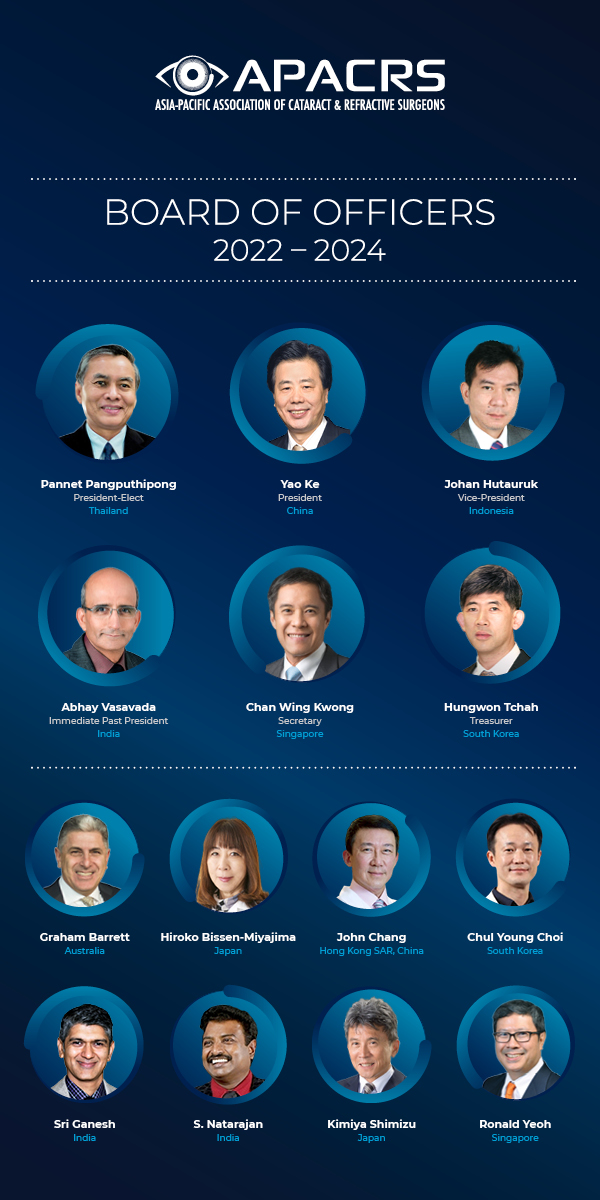
 EyeSustain Update
EyeSustain Update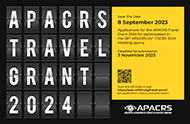 2024 APACRS TRAVEL GRANT
2024 APACRS TRAVEL GRANT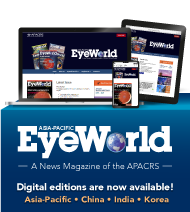 Digital EyeWorld
Digital EyeWorld VOL. 39 (2023), ISSUE 3
VOL. 39 (2023), ISSUE 3  Membership Information
Membership Information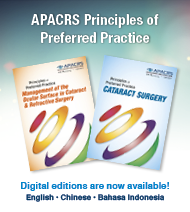 APACRS Principles of Preferred Practice
APACRS Principles of Preferred Practice